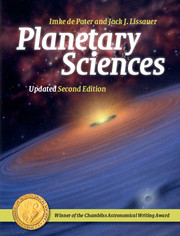Book contents
- Frontmatter
- Contents
- List of Tables
- Preface
- 1 Introduction
- 2 Dynamics
- 3 Solar Heating and Energy Transport
- 4 Planetary Atmospheres
- 5 Planetary Surfaces
- 6 Planetary Interiors
- 7 Magnetic Fields and Plasmas
- 8 Meteorites
- 9 Minor Planets
- 10 Comets
- 11 Planetary Rings
- 12 Extrasolar Planets
- 13 Planet Formation
- Appendix A List of Symbols Used
- Appendix B Acronyms Used
- Appendix C Units and Constants
- Appendix D Periodic Table of Elements
- Appendix E Observing Techniques
- Appendix F Interplanetary Spacecraft
- Appendix G Recent Developments in Planetary Sciences
- References
- Index
- Plate Section
- References
12 - Extrasolar Planets
Published online by Cambridge University Press: 05 January 2015
- Frontmatter
- Contents
- List of Tables
- Preface
- 1 Introduction
- 2 Dynamics
- 3 Solar Heating and Energy Transport
- 4 Planetary Atmospheres
- 5 Planetary Surfaces
- 6 Planetary Interiors
- 7 Magnetic Fields and Plasmas
- 8 Meteorites
- 9 Minor Planets
- 10 Comets
- 11 Planetary Rings
- 12 Extrasolar Planets
- 13 Planet Formation
- Appendix A List of Symbols Used
- Appendix B Acronyms Used
- Appendix C Units and Constants
- Appendix D Periodic Table of Elements
- Appendix E Observing Techniques
- Appendix F Interplanetary Spacecraft
- Appendix G Recent Developments in Planetary Sciences
- References
- Index
- Plate Section
- References
Summary
Since one of the most wondrous and noble questions in Nature is whether there is one world or many, a question that the human mind desires to understand, it seems desirable for us to inquire about it.
Albertus Magnus, 13th centuryThe first eleven chapters of this book covered general aspects of planetary properties and processes, and described specific objects within our Solar System. We now turn our attention to far more distant planets. What are the characteristics of planetary systems around stars other than the Sun? How many planets are typical? What are their masses and compositions? What are the orbital parameters of individual planets, and how are the paths of planets orbiting the same star(s) related to one another? What are the relationships between stellar properties such as mass, composition, and multiplicity and the properties of the planetary systems that orbit them? These questions are hard to answer because extrasolar planets, often referred to as exoplanets, are far more difficult to observe than are planets within our Solar System.
Just as the discoveries of small bodies orbiting the Sun have forced astronomers to decide how small an object can be and still be worthy of being classified as a planet (Chapter 9), detections of substellar objects orbiting other stars have raised the question of an upper size limit to planethood. We adopt the following definitions, which are consistent with current International Astronomical Union (IAU) nomenclature:
• Star: self-sustaining fusion is sufficient for thermal pressure to balance gravity (≳0.075 M⊙ ≈ 80 M2 for solar composition; the minimum mass for an object to be a star is often referred to as the hydrogen burning limit).
• Stellar remnant: dead star–no more fusion (or so little that the object is no longer supported primarily by thermal pressure).
• Brown dwarf: substellar object with substantial deuterium fusion–more than half of the object's original inventory of deuterium is ultimately destroyed by fusion.
• Planet: negligible fusion (≲0.012 M⊙ ≈ 13 M2, with the precise value again depending upon composition), plus it orbits one or more stars and/or stellar remnants.
Information
- Type
- Chapter
- Information
- Planetary Sciences , pp. 489 - 511Publisher: Cambridge University PressPrint publication year: 2015
